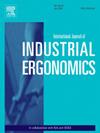基于仿真的多目标优化与用于乘员包装设计的 DHM 工具相结合
IF 2.5
2区 工程技术
Q2 ENGINEERING, INDUSTRIAL
International Journal of Industrial Ergonomics
Pub Date : 2025-01-01
DOI:10.1016/j.ergon.2024.103690
引用次数: 0
摘要
本文章由计算机程序翻译,如有差异,请以英文原文为准。
Simulation-based multi-objective optimization combined with a DHM tool for occupant packaging design
Occupant packaging design is usually done using computer-aided design (CAD) and digital human modelling (DHM) tools. These tools help engineers and designers explore and identify vehicle cabin configurations that meet accommodation targets. However, studies indicate that current working methods are complicated and iterative, leading to time-consuming design procedures and reduced investigations of the solution space, in turn meaning that successful design solutions may not be discovered. This paper investigates potential advantages and challenges in using an automated simulation-based multi-objective optimization (SBMOO) method combined with a DHM tool to improve the occupant packaging design process. Specifically, the paper studies how SBMOO using a genetic algorithm can address challenges introduced by human anthropometric and postural variability in occupant packaging design. The investigation focuses on a fabricated design scenario involving the spatial location of the seat and steering wheel, as well as seat angle, taking into account ergonomics objectives and constraints for various end-users. The study indicates that the SBMOO-based method can improve effectiveness and aid designers in considering human variability in the occupant packaging design process.
求助全文
通过发布文献求助,成功后即可免费获取论文全文。
去求助
来源期刊
CiteScore
6.40
自引率
12.90%
发文量
110
审稿时长
56 days
期刊介绍:
The journal publishes original contributions that add to our understanding of the role of humans in today systems and the interactions thereof with various system components. The journal typically covers the following areas: industrial and occupational ergonomics, design of systems, tools and equipment, human performance measurement and modeling, human productivity, humans in technologically complex systems, and safety. The focus of the articles includes basic theoretical advances, applications, case studies, new methodologies and procedures; and empirical studies.

 求助内容:
求助内容: 应助结果提醒方式:
应助结果提醒方式:


